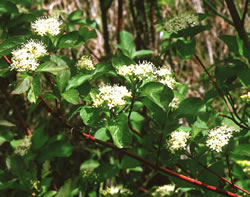Plant of the Week
 Cornus sericea range map. USDA PLANTS Database.
Cornus sericea range map. USDA PLANTS Database.
 Umbel of white flowers and oval leaves of Cornus sericea from City Creek Canyon, Salt Lake County, Utah. Photo © Bill Gray.
Umbel of white flowers and oval leaves of Cornus sericea from City Creek Canyon, Salt Lake County, Utah. Photo © Bill Gray.
 Closeup of the flowers of Cornus sericea, from Bell’s Canyon, Salt Lake County, Utah. Photo © Steve Hegji.
Closeup of the flowers of Cornus sericea, from Bell’s Canyon, Salt Lake County, Utah. Photo © Steve Hegji.
 Closeup of the white, berry-like fruits of Cornus sericea, fromBig Cottonwood Canyon, Salt Lake County, Utah. Photo © Steve Hegji.
Closeup of the white, berry-like fruits of Cornus sericea, fromBig Cottonwood Canyon, Salt Lake County, Utah. Photo © Steve Hegji.
Red Osier Dogwood (Cornus sericea L. ssp. sericea)
By Walter Fertig
Of the approximately 50 species of dogwood (genus Cornus) found worldwide, 16 are native to the United States. Red osier dogwood (Cornus sericea L. ssp. sericea) is our most widespread native species, occurring over most of the continent except for the southern Great Plains and the southeast. Cornus sericea is a 3 to 9 foot tall shrub that can be recognized by its flat, umbrella-like cluster of small four or five-petal white flowers and oval leaves with prominent veins that gently curl to trace the shape of the leaf margin. Red osier lacks the showy petal-like leafy bracts surrounding the flower clusters that are characteristic of the flowering dogwood (Cornus florida), but still makes a showy garden plant for its foliage and bright red stems (red-osier is French for “red willowy shoot” based on the resemblance of winter dogwoods to leafless willows.
The most reliable way to identify any dogwood is to carefully break the petiole (leaf stalk) and slowly pull each half apart to reveal the stringy white pith inside. Pith is part of the network of fibers that give a stem its strength and flexibility. Dogwood pith is unusual in its rubbery elasticity which allows it to be pulled like cotton candy batter (though it is less edible and brightly colored).
Red-osier dogwood was one of several plants referred to as “kinnikinik” by American Indians for its use as a tobacco substitute. The inner bark of young stems was split and scraped into threads and toasted over a fire before being mixed with real tobacco. Edible plant enthusiast H.D. Harrington wrote that Red-osier “is said to be aromatic and pungent, giving a narcotic effect approaching stupefaction”. He recommended its use only in moderation.
For centuries, humans have also used the hard wood of dogwood for basketry, wicker, farm implements, and weaving shuttles. The word dogwood, in fact, is a corruption of the Scandinavian term “dag” meaning skewer (for the hardened sticks used to roast meat). Although the word has nothing to do with our canine companions, it still allows for the clever botanical joke, always worth repeating: How do you tell it is a dogwood? By its bark, of course!

